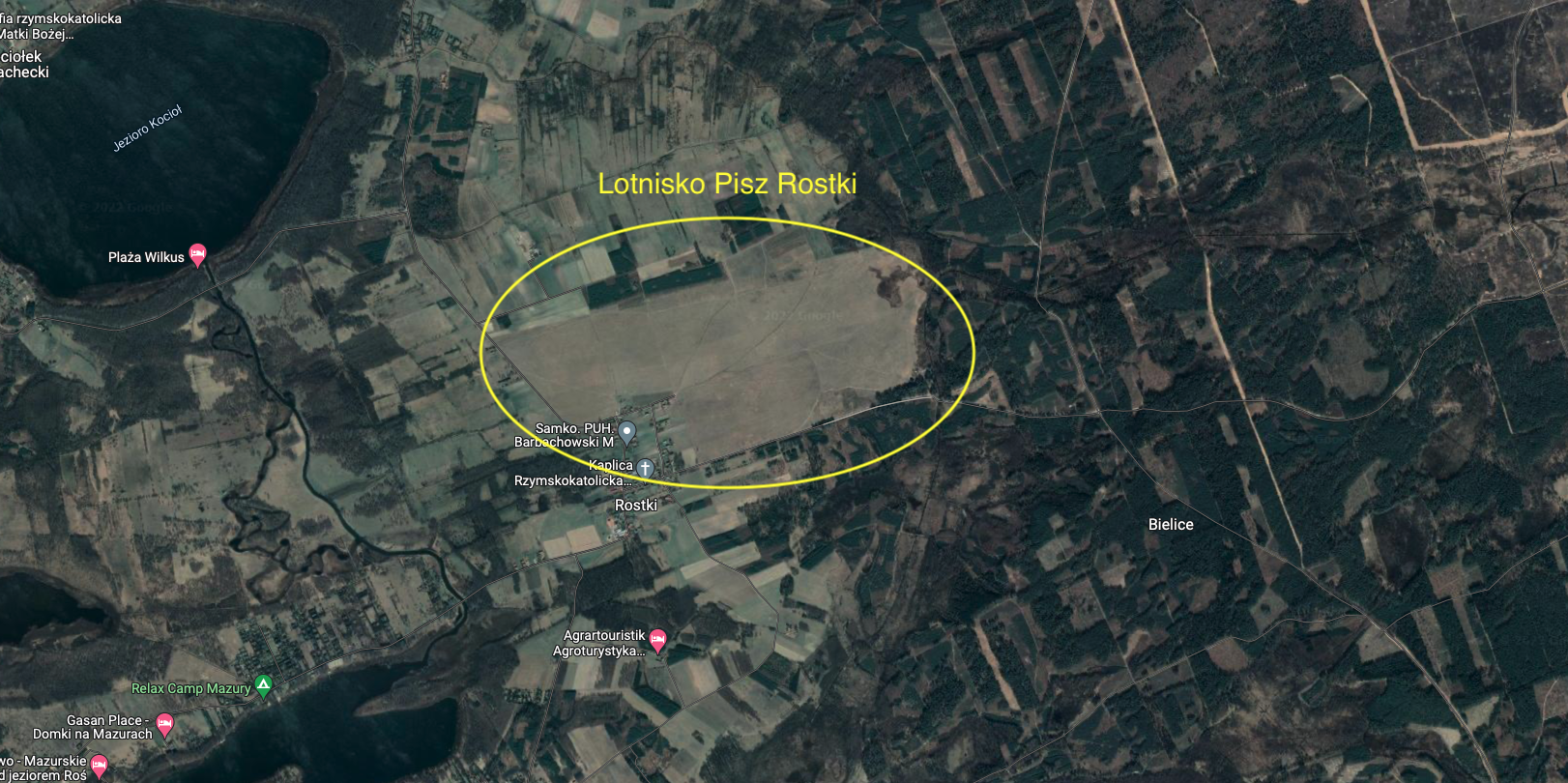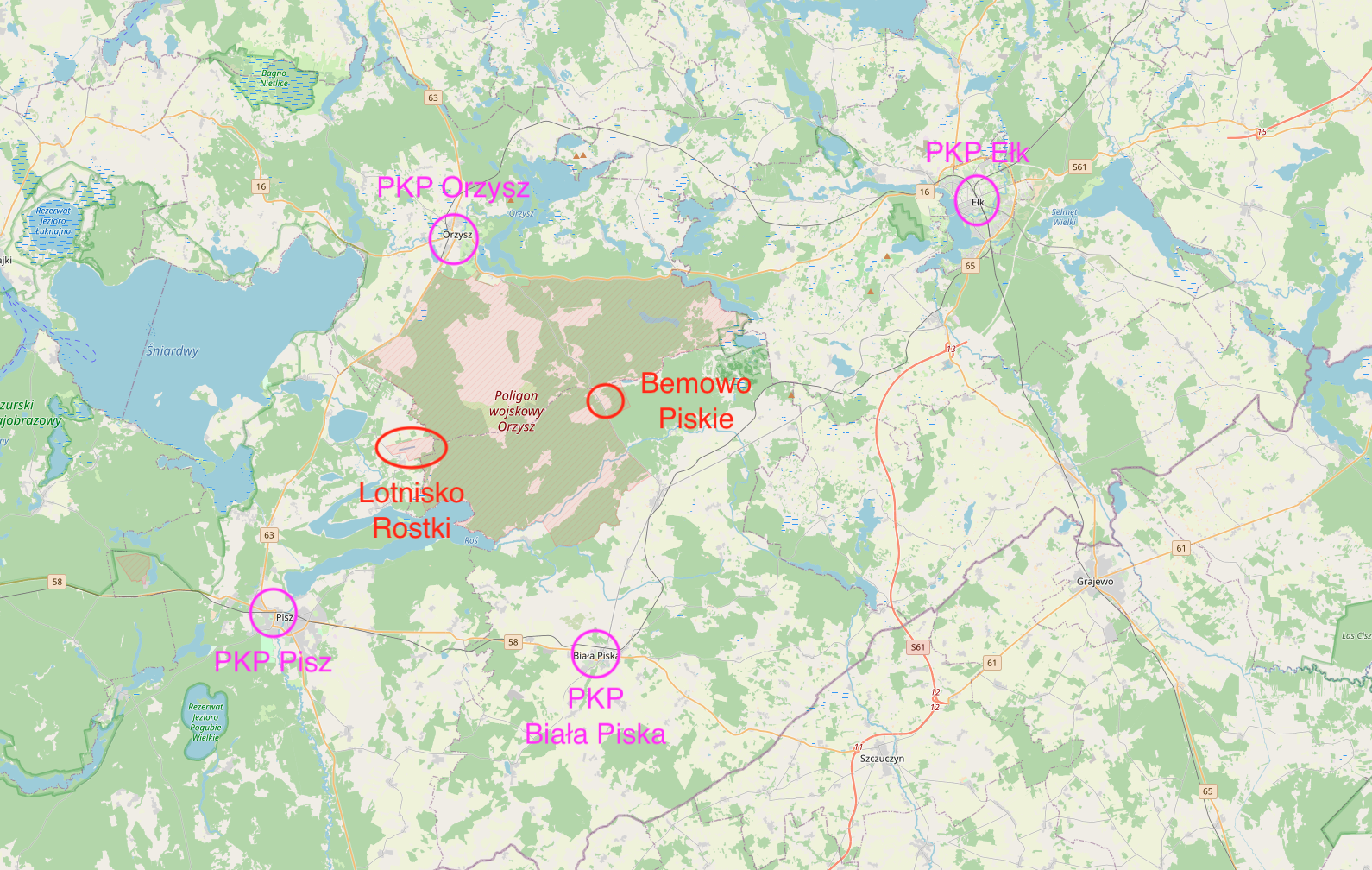Pisz 2023-01-03
Pisz airport, Rostki and Orzysz training ground, Bemowo Pilskie.
Pisz - Rostki airport, geographical coordinates: 53.709N 21.907E. Elevation: 375 ft = 114 m.


The area we are interested in is located in a quadrangle defined by four cities: Orzysz, Ełk, Biała Piska and Pisz. This area is located in Masuria and for most of its history it belonged to the Polish Crown, and then to East Prussia, which in 1772 was seized by Germanic tribes, after murdering the indigenous inhabitants - Yotvingians and Prussians. It was successively; The Province of Prussia in the period 1772 - 1871, Prussia in the period 1871 - 1918, the German Empire in the period 1919 - 1933, the Weimar Republic of the Third Reich in the period 1933 - 1945. During the Great World War, in the period 1914 - 1915, the Great Lakes area was Muscovites. Despite Germany losing the war, East Prussia remained under German administration. In 1920, a plebiscite was held among the local population, which opted for belonging to East Prussia. As a result of the Second World War started by the Germans and Muscovites, in 1945, this area was incorporated into the Republic of Poland. Administratively, the Warmińsko-Mazurskie Voivodship is here.
Rostki airport.
The most correct name of the airport is the name of Rostka, because the airport is located in this town. The name Pisz is also used, which is the largest town near the airport. (Pilla County). You can also come across the name Orzysz Airport, because for many years the airport was used by the army. And you should know that there is an active training ground of the Polish Army and the Ground Forces Training Center (OSPWL) near the airport.
The history of the Rostki airport began in the autumn of 1936, when a small single-engine plane landed in a meadow. The task of people on board the plane was to choose a place for the new airport. At that time, Adolf Hitler had already been in power for three years and was already building up the armed forces. People who flew to Rostek were representatives of the Command of the Königsberg Aviation District (Królewiec). At that time, a nearby cavalry and artillery training ground was already in operation, which was established in 1890. The training ground was built on the land purchased from the landowners of the villages of Wierzbiny and Szwejkówko and the nearby forests. The first barracks were built in Orzysz in 1895. In 1900, the army already had 80 barracks for about 1,000 soldiers and officers. The barracks in Orzysz formed a military town with its own water supply, lighting, post office, shops, restaurant and military casino.
Residents of the surrounding towns were employed to build the new airport, and the Reich Labor Service (RAD) junaks were brought in from various parts of the Reich. The airport was put into use in the fall of 1938, although not all facilities were put into use. The airport received the codename "Orzysz-Rostki field airport" (Feldflugplatz Arys-Rostken). Apart from the airports: Kętrzyn - Wilamowo and Szyman, the Rostki airport became the main airports in East Prussia. As in Kętrzyn, three concrete RWYs were built in Rostki. The construction of concrete RWYs was necessary because the area was wet, and in the spring it would be impossible for planes to take off. The runways were 600 m x 20 m. But from the air they resembled circular roads. A bomb depot and a fuel depot were built in the forest, with tanks placed in the ground. There were several hangars at the airport, which were stylized as barns. Aircraft stands were placed among the trees.
On September 1, 1939, combat aircraft took off from the airport to bomb Warsaw. Then in 1941, the Germans used the airport to attack the Muscovites.
After the Second World War, from 1946, the Rostki airport was managed by the Polish Army. The airport was not used intensively because there was no concrete RWY here.
Since the 80s of the twentieth century, during the period of temporary heat and droughts, the PZL M-18 Dromader aircraft have been based at the airport to extinguish possible fires.
Rostki airport is available for civilian aircraft, but you need to obtain the consent of the manager of the airstrip (Polish Army) and the consent of the commandant of the training ground in Orzysz. We recommend making the first call to the duty officer of the training ground. RWY is flagged and capable of visual flight operations. The landing field is even and long enough. There are two dirt roads running across the RWY, so be careful.
Rostki airport details:
The airport is registered as an airstrip. Registration number ULC 237. The take-off field is a dirt one, on which one RWY is usually marked, with dimensions of 870 x 80 m, in the direction 078/258. Radio: 130.300MHz. The helipad is part of the closed range area.
Orzysz training ground.
In 1890, the German army established a cavalry and artillery training ground. When the decision to build the Rostki airfield was made, the decision was made to enlarge the training ground. In 1934 - 1937, the inhabitants of two more villages were displaced. In the area of the village of Wierzbiny (Schlagakrug), now Bemowo Piskie, a large camp consisting of wooden barracks and another barracks were built. There was a division: the year-round barracks were in Orzysz, and the summer barracks in Bemowo Pilskie. In the interwar period, research on the effectiveness of artillery and small arms was carried out at the training ground. A system of bunkers was built to observe the operation and evaluate the effectiveness of artillery shells.
In September 1939, camouflage nets were placed on the landing field and the hangars were painted in camouflage colors. On the so-called cemetery hill, among the trees, an observation tower was built. Practically the entire area was fenced off with concrete posts and barbed wire. A system of guardhouses and shelters for guards was developed.
During the Second World War, military facilities served two main purposes; soldiers were trained here before being sent to the front, and new armament was tested here: tanks, armored vehicles, ammunition, and even elements of missiles.
Orzysz training ground in Poland.
After 1945, the training ground and the airport became part of Poland, but under the management of the Soviets. The area was closed to civilians. From year to year, the military significance of the facility, in which no investments were made, decreased. Most of the concrete slabs from the airport runways moved to new places as roads and squares. At the end of the 50s, some of the panels went to the military unit in Orzysz, where a helipad was made.
In January 1946, a detached unit of the Military Training Command was established in Orzysz, already under Polish command. The unit was transformed into the Command of the Artillery Training Ground No. 3. In the period 1946 - 1970, the training ground had various names to finally adopt the name of the Land Forces Training Center Orzysz (OSPWL), which name is still in use (2023).
The Orzysz training ground is more often known as Bemowo Pilskie. The Land Forces Training Center is located here. Driving along the commune road from Drygały (Provincial Road No. 667) towards Orzysz (north), there are warning signs everywhere - Military Area No Entry, in four languages; Polish, English, German and Russian. Many smaller areas are fenced off. After years of underinvestment in the Polish Army by the ruling freemasonry, the situation has improved significantly in recent years. The facilities are being renovated and new ones are being built. The training ground headquarters is located in Bemowo Pilskie, and previously it was located in Orzysz. The training ground is intended for land forces from various parts of Poland, as well as for the armies of other NATO countries.
Throughout the period of operation, the training ground was expanded due to the change of tasks from artillery to general military, but highly specialized in operations on the modern battlefield. Currently, the training ground has facilities where it is possible to fire all types of small arms, armored weapons, artillery, on-board weapons of aircraft, helicopters (for ground targets) and to carry out bombings. The training ground also serves as a place of training and preparation for subunits of the Polish Army participating in military missions abroad. The training ground has a rich social and living security. 1,500 soldiers can train at the training ground at the same time, for whom there are social rooms and there is no need to set up tents and light field kitchens. On the premises there is a canteen, buffet, bathhouse, training block, garrison club, common rooms.
Currently, in 2023, the training ground covers an area of 16,000 hectares, or 160 square kilometers. The car park can accommodate 400 vehicles at a time.
The field training ground includes: Wierzbiny exercise yard, artillery and anti-tank guided missile shooting range, two infantry shooting ranges Gaudynek and Bemowo Piskie, two combat grenade launchers at Strzelinki and Gaudynek, Gaudynek tactical track, engineering and sapper training site Wyręby, reconnaissance training area Klusy, area for overcoming water obstacles, covered firing positions Sosna, Ośla Łączka and Gaudynek, air bombing area Kościelisko, field airfield Rostki, helipad Orzysz and Bemowo Piskie, two areas for camps Wierzbiny and Bemowo Piskie.
Written by Karol Placha Hetman
